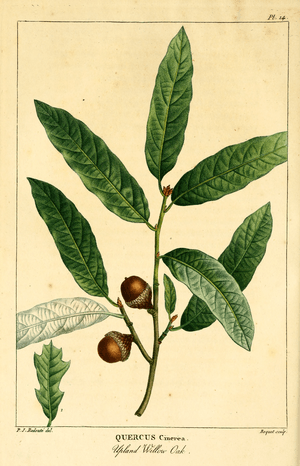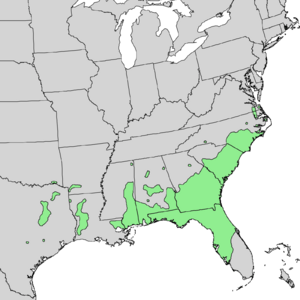Bluejack oak facts for kids
Quick facts for kids Bluejack oak |
|
|---|---|
 |
|
| Conservation status | |
| Scientific classification | |
| Genus: |
Quercus
|
| Species: |
incana
|
 |
|
| Natural range | |
| Synonyms | |
|
List
Dryopsila cinerea (Michx.) Raf.
Dryopsila oligodes Raf. Dryopsila verrucosa Raf. Quercus brevifolia Sarg. 1895 not Kotschy ex A. DC. 1864 Quercus cinerea Michx. Quercus cinerea Raf. Quercus cinerea var. dentatolobata A.DC. Quercus cinerea f. dentatolobata (A.DC.) Trel. Quercus cinerea var. humilis (Pursh) A.DC. Quercus heterophylla Raf. 1838 not F.Michx. 1812 Quercus humilis Walter 1788 not Mill. 1768 Quercus ilexoides Raf. Quercus oligodes Raf. Quercus phellos var. brevifolia Lam. Quercus phellos var. humilis Pursh Quercus phellos var. latifolia Marshall Quercus verrucosa Raf. |
|
The Bluejack Oak (scientific name: Quercus incana) is a type of oak tree. It's also known by other names like upland willow oak or cinnamon oak. This tree grows naturally in the southeastern parts of the United States. You can find it along the Atlantic and Gulf coastal plains, from Virginia all the way to Texas. It also grows inland in states like Oklahoma and Arkansas.
Contents
About the Bluejack Oak
What Does It Look Like?
The Bluejack Oak is usually a medium-sized tree. It typically grows to about 10 meters (33 feet) tall. Some can even reach up to 15 meters (51 feet) in height. One very large Bluejack Oak in Texas was 15.5 meters tall. Its trunk was about 2.1 meters (7 feet) around. The branches of this tree are often crooked. They form a crown that looks open and a bit uneven.
The bark of the Bluejack Oak is dark brown or black. It has a scaly or "platy" texture. The leaves are usually oval-shaped. They can be up to 10 centimeters long and 3.5 centimeters wide. The top side of the leaves is a shiny green. The underside feels soft and woolly because it's covered in fine hairs.
Its Acorns and How It Grows
Like all oaks, the Bluejack Oak produces acorns. These acorns are about 1.7 centimeters long and 1.6 centimeters wide. The tree can grow new plants in two ways. It can grow from seeds found in its acorns. It can also regrow from its roots if the top part of the tree is cut down or burned. Sometimes, it spreads underground runners. This can create dense groups of trees called thickets.
Where Does It Grow?
Bluejack Oaks often live in longleaf pine forests. In these areas, they share space with other trees like turkey oak and plants like wiregrass. In a large forest area in Texas called the Big Thicket, Bluejack Oaks grow alongside post oaks and different types of pine trees.
This oak prefers sandy soils. It often grows on slopes below hilltops. The soil there is usually finer and not as dry as on the very top of the ridges.
Bluejack Oak and Wildfire
The Bluejack Oak is very good at surviving wildfires. It lives in places where fires happen often. In fact, these fires are often needed for the ecosystem to stay healthy. The Bluejack Oak doesn't like a lot of shade. Fires help by clearing away taller, stronger oaks that would otherwise block the sunlight. This allows the Bluejack Oak to thrive.
Uses and Wildlife
The wood from the Bluejack Oak is strong and hard. However, these trees are usually too small to be used for building big things. Their wood is mostly used for fuel or fence posts.
The acorns of the Bluejack Oak are an important food source. Many animals eat them. For example, the Sherman's fox squirrel eats these acorns. This type of squirrel often lives in the same longleaf pine forests as the Bluejack Oak.
See also
 In Spanish: Quercus incana para niños
In Spanish: Quercus incana para niños


